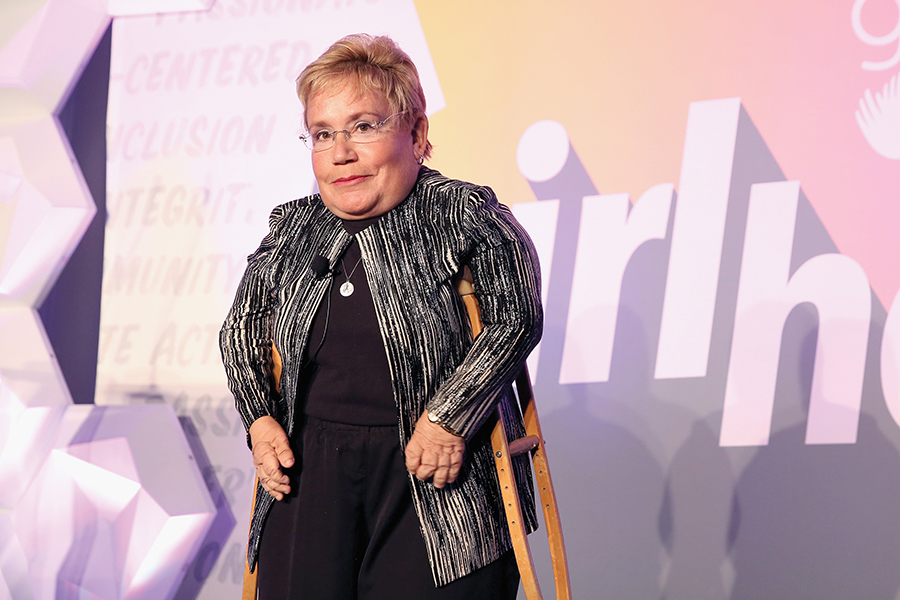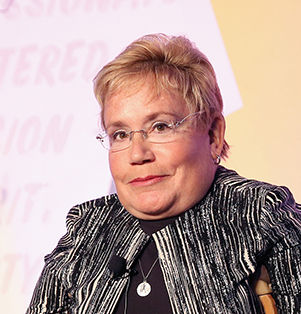Born with a rare form of dwarfism, Michele Sullivan has spent her life looking up. As the first female president of the Caterpillar Foundation, she uses her unique point of view to impact countless lives around the world. Here, she recounts her early strategies and how the responsibility of finding millions of dollars to give to worthy causes has given her valuable life lessons.
One of my first orders of business at the foundation was reframing the way we operated. I knew it would cause quite a stir, but now that the role was mine, I was going to make some changes. The foundation board, my team, and I, set an aspirational goal to impact the lives of 50 million people living in poverty within eight years. That meant different things to different people. To me, it meant life change, seeing families no longer living in the poverty that had plagued them for generations. It meant seeing children in school and graduating into a job that allowed them to provide for their families. It meant building wells in desperate areas, and also ensuring that the girls who spent each day gathering water became educated, too. It meant that communities who used the wells became healthier and that children no longer died from waterborne disease.
I needed a way to track this impact. My math brain went full scale. I spent the first few months observing how things operated. I wanted to understand the elements that worked and uncover areas where we could improve. More than anything, I wanted to know where I could best serve the foundation’s mission to impact the lives of those in poverty. It’s easy to assume a company like Caterpillar has unlimited resources. While the company has a lot to give from a financial standpoint, the two critical resources money can’t buy are the right vision and the right partnerships. I needed individuals with viewpoints that compelled them to work with us and to carry out the work that needed to be done.
My primary role as president was determining the strategy for investing millions in grant money every year to create sustainable change in individual lives. I took maximizing every single dollar very seriously. In 2012, I rolled out a new operational strategy for the foundation that fundamentally changed how we measured ROI. Typically, foundations and their grantees measure returns by output — for example, how many schools were built or how many microloans were issued. While this certainly measures the productivity of a foundation and isn’t irrelevant, I don’t believe it measures actual, long-term impact. I wanted our foundation to always have a sense of what grants had the most significant impact and how many lives were truly elevated by our investments. This entailed creating a metric to track details such as how many recipients of microloans broke their family’s cycle of poverty. Knowing that sort of data would tell us how much impact we were having.
This new strategy meant new grantee reporting rules around the measurement of outcome, instead of output. It was a stark change for many of them. Dozens of calls, letters, and emails came in from nonprofits which were not accustomed to the change. Our team worked with these organizations to help them create the right metrics. Eventually, their perspectives changed when their ability to prove that impact was happening opened up additional funding from sources that required this data.
Essentially, I wanted to know if we were defeating poverty and, if not, what needed to change? What more did we need to see or understand? Through hands-on research, asking lots of questions, and spending time with both our grantees and the individuals they were helping, it became clear that as the woman goes, so goes the family. If women are documented from birth, educated, given support for their businesses, and married after becoming an adult, their chances of success are exponentially higher, and their family follows suit. With this knowledge, we created a proprietary collaborative platform known as Together. Stronger.
Its name reveals the core initiative: ToGetHer Stronger. The objective became a pillar of our investments and emphasized monetary accountability — dollar-to-impact behavior — and strategic alliances across public, private, and nonprofit sectors. I knew we couldn’t see and help 50 million people alone. Our partners make the impact.
One year after I took over, we contributed a grant to Water.org to expand its microfinance program, WaterCredit, which allows families in poverty to borrow money to purchase toilets or get clean water piped to their homes. The initial effect was that the number of people who gained access to clean water jumped to 3.2 million. We didn’t stop there. We connected Water.org with Opportunity International, one of our other partners, to increase capital to provide more WaterCredit loans.
The vision to bring water to all these desperate people wasn’t mine. It was the vision of actor Matt Damon and Gary White. It wasn’t my vision to provide microloans to help people start farms and businesses and meet basic needs. That was the vision of Al Whittaker, former president of Bristol-Myers International Corporation, and Australian entrepreneur David Bussau. It wasn’t even my vision to build the world’s largest construction equipment manufacturer. I just work there. But I knew how to look up to people. Together with a few others who also knew how, we were able to bring about exponential change well beyond the number of people our individual visions could reach.
Today, Water.org has helped 17 million people access clean water. Opportunity International has provided financial products to nearly 15 million people in 20 countries. For our vision to have its most significant impact, we have to trade credit and recognition for collaboration. Looking up to others is, after all, about others. It’s not about us.
The change in approach was never about bureaucracy or introducing more red tape into the process. It certainly wasn’t about control. It was about the need to stop generalizing our approach to how we help people. It was also about introducing accountability into our efforts, so that seeing people in bad circumstances doesn’t end with just feeling empathy. It was ultimately about stewardship of vision — making the best use of the insight we’d been given into multiple lives — male or female, a retired white American attorney, or a single African-American mother. Many people have modeled this conviction around stewardship for me over the years, but my mom is at the top of the list. She continues to see me and step in to see with me. I don’t think she’s ever considered how much her insight into my life became one of the dominoes from which my future progress has flowed — since I was a little girl born with dwarfism and big dreams.
This is an excerpt from Michele L. Sullivan’s new book, Looking Up: How a Different Perspective Turns Obstacles Into Advantages.




































